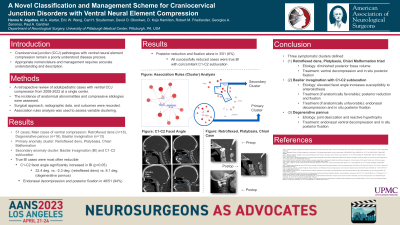A Novel Classification of Compressive Craniocervical Junction Disorders
Friday, April 21, 2023


Hanna N. Algattas
Neurosurgery Resident
UPMC
Pittsburgh, Pennsylvania, United States
ePoster Presenter(s)
Introduction: Ventrally compressive craniocervical junction (CCJ) pathologies, ranging from basilar invagination (BI) to pannus formation are a poorly understood group.
Methods: A retrospective review of adult and pediatric cases with ventral CCJ compression from 2008 to 2022 was performed. The incidence of different anatomical abnormalities of the CCJ was assessed.
Results: Fifty-one cases were identified. The predominant factors causing ventral compression were: retroflexed dens (n=18), degenerative C1-C2 pannus (n=16), and BI (n=13). Association rules analysis identified a cluster of anomalies with large overlap for retroflexed dens, platybasia, and Chiari.
Reducibility was evaluated based on preoperative imaging. Of 13 cases with BI, 12 were deemed reducible (92.0%). By comparison, 2/18 cases with retroflexed dens were deemed reducible (11.1%), both of which had concomitant BI. Degenerative pannus cases were not reducible. A large C1-C2 facet angle was associated with BI. The average C1- C2 angle was 32.4 degrees in BI, compared to -2.3 degrees for retroflexed dens, and 8.1 degrees for degenerative pannus (p < 0.05).
Surgical approach was endonasal decompression followed by posterior fixation in 48 cases (94.0%) whereas posterior reduction and fixation alone occurred in three cases (6.0%). A total of 16 reducible cases were identified, 12 of which had BI. Of those, posterior reduction alone was successful in 3/5 cases (60.0%), with all successful cases being of BI.
Conclusion : Based on the observed anatomical features, reducibility, and biomechanical abnormalities present, a global classification paradigm is proposed. One category causes posterior fossa volume constraint due to retroflexed dens, platybasia, and Chiari and often require ventral decompression followed by fixation. Second is C1-C2 subluxation with large C1-C2 angle and BI. Open posterior reduction may be an appropriate initial choice, albeit ventral decompression with fixation also provided good outcome. Last is pannus formation due to C1-C2 joint degeneration and hypertrophy, often benefitting from immediate decompression and fixation.
Methods: A retrospective review of adult and pediatric cases with ventral CCJ compression from 2008 to 2022 was performed. The incidence of different anatomical abnormalities of the CCJ was assessed.
Results: Fifty-one cases were identified. The predominant factors causing ventral compression were: retroflexed dens (n=18), degenerative C1-C2 pannus (n=16), and BI (n=13). Association rules analysis identified a cluster of anomalies with large overlap for retroflexed dens, platybasia, and Chiari.
Reducibility was evaluated based on preoperative imaging. Of 13 cases with BI, 12 were deemed reducible (92.0%). By comparison, 2/18 cases with retroflexed dens were deemed reducible (11.1%), both of which had concomitant BI. Degenerative pannus cases were not reducible. A large C1-C2 facet angle was associated with BI. The average C1- C2 angle was 32.4 degrees in BI, compared to -2.3 degrees for retroflexed dens, and 8.1 degrees for degenerative pannus (p < 0.05).
Surgical approach was endonasal decompression followed by posterior fixation in 48 cases (94.0%) whereas posterior reduction and fixation alone occurred in three cases (6.0%). A total of 16 reducible cases were identified, 12 of which had BI. Of those, posterior reduction alone was successful in 3/5 cases (60.0%), with all successful cases being of BI.
Conclusion : Based on the observed anatomical features, reducibility, and biomechanical abnormalities present, a global classification paradigm is proposed. One category causes posterior fossa volume constraint due to retroflexed dens, platybasia, and Chiari and often require ventral decompression followed by fixation. Second is C1-C2 subluxation with large C1-C2 angle and BI. Open posterior reduction may be an appropriate initial choice, albeit ventral decompression with fixation also provided good outcome. Last is pannus formation due to C1-C2 joint degeneration and hypertrophy, often benefitting from immediate decompression and fixation.
